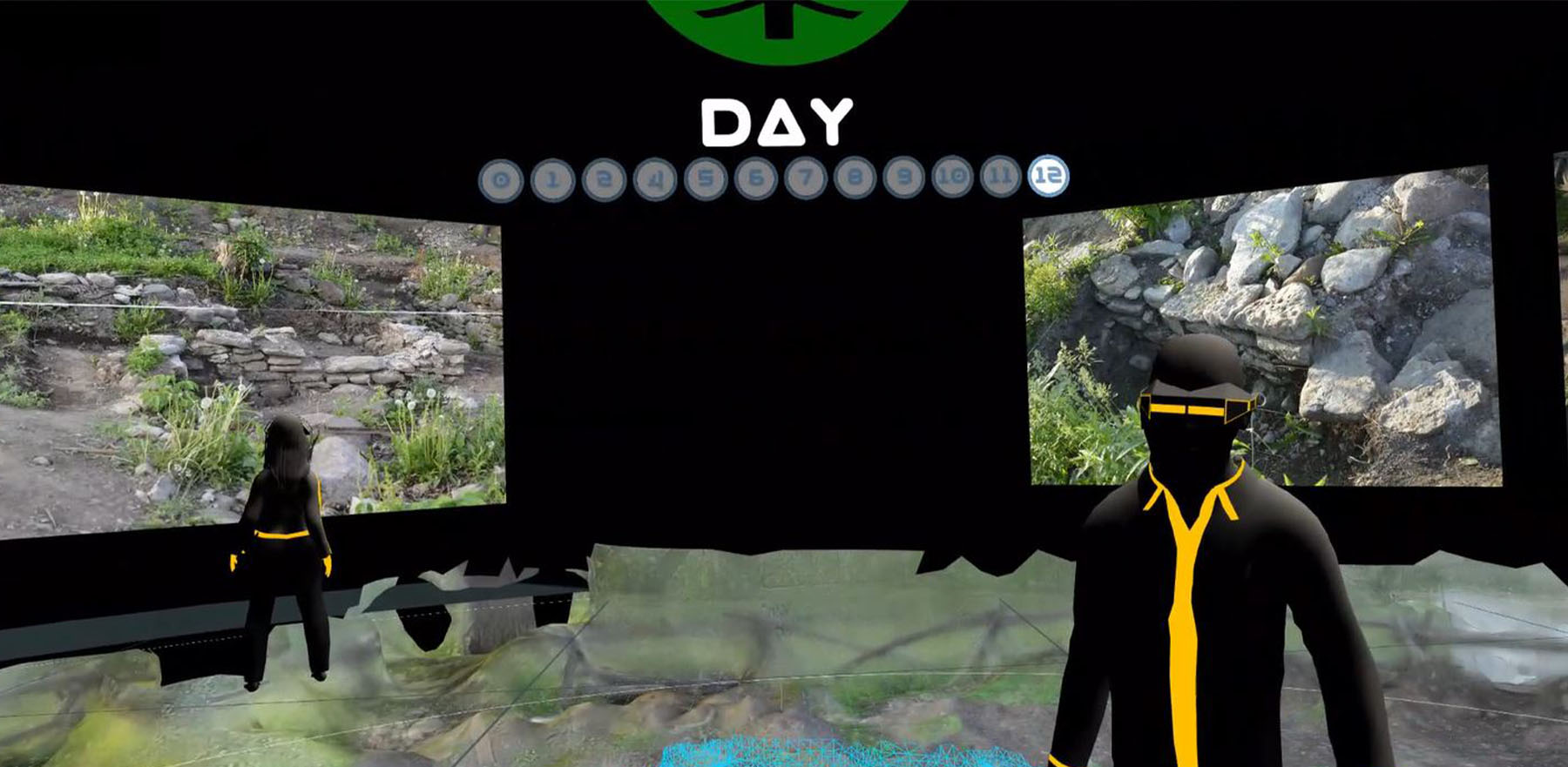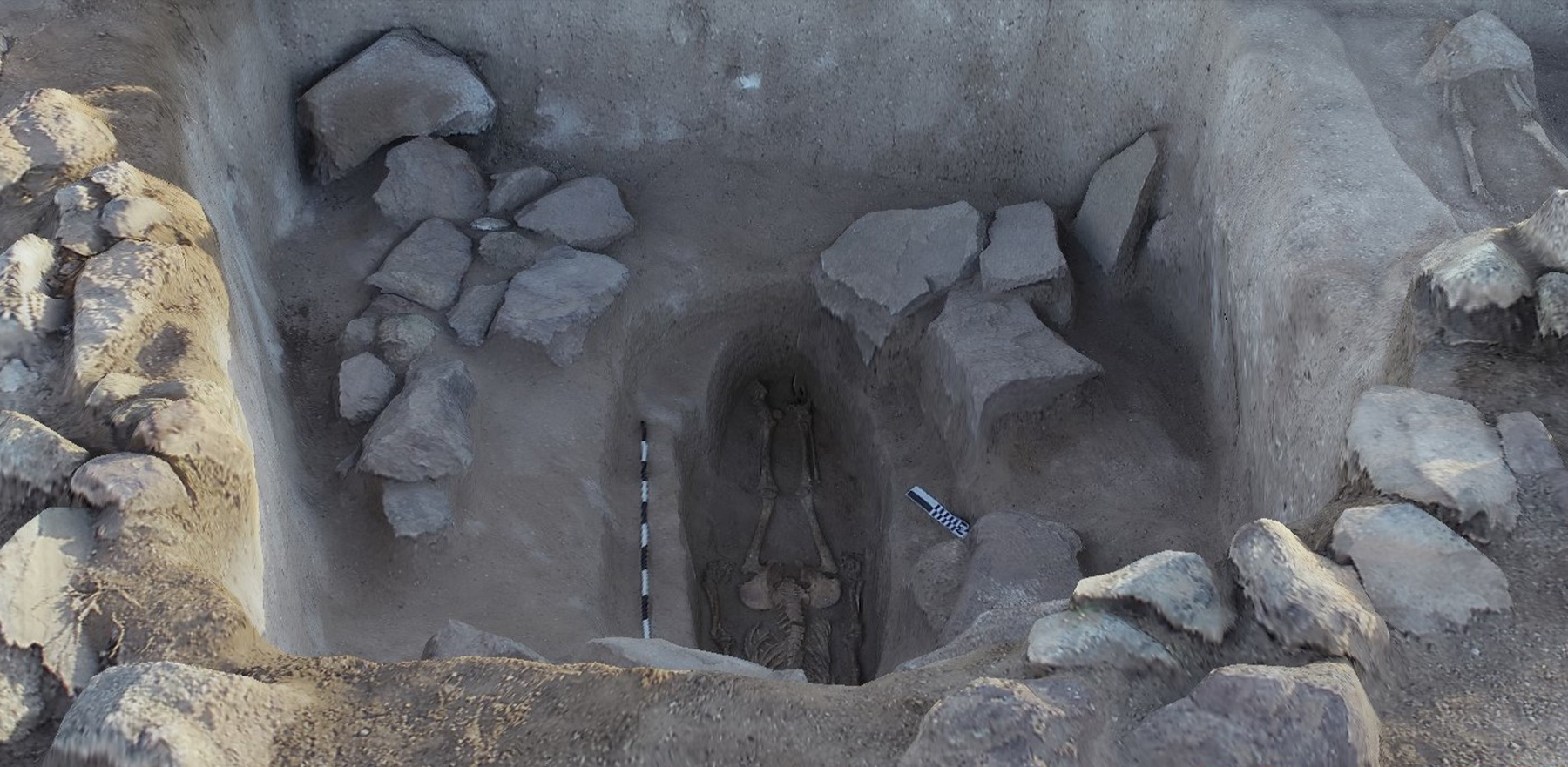Broken Obelisk, Egypt
“Tanis is in Nile Delta, Egypt, where is about 140-km northeast of Cairo, a name of town in Ancient Egyptian Era, and this town is currently called San el-Hagar.
Tanis has once been a capital in 21st – 23rd Dynasty, Third Intermediate Period (11th – 9th century BC). Although Tanis was a capital, but there was another capital town in Upper Egypt, Thus Egypt was not formed as a Unified Kingdom.”
Citation link
Model info link
Cave of Hands
“The Cueva de las Manos, Río Pinturas, contains an exceptional assemblage of cave art, executed between 13,000 and 9,500 years ago. It takes its name (Cave of the Hands) from the stencilled outlines of human hands in the cave, but there are also many depictions of animals, such as guanacos (Lama guanicoe), still commonly found in the region, as well as hunting scenes. The people responsible for the paintings may have been the ancestors of the historic hunter-gatherer communities of Patagonia found by European settlers in the 19th century.”
Citation: link
Model info link
Colosseum Facade
“Located just east of the Roman Forum, the massive stone amphitheater known as the Colosseum was commissioned around A.D. 70-72 by Emperor Vespasian of the Flavian dynasty as a gift to the Roman people. In A.D. 80, Vespasian’s son Titus opened the Colosseum–officially known as the Flavian Amphitheater–with 100 days of games, including gladiatorial combats and wild animal fights. After four centuries of active use, the magnificent arena fell into neglect, and up until the 18th century it was used as a source of building materials. Though two-thirds of the original Colosseum has been destroyed over time, the amphitheater remains a popular tourist destination, as well as an iconic symbol of Rome and its long, tumultuous history.”
Citation link
Model info link
Fontana del Mascherone di Santa Sabina
“It is made up of two pieces of reuse: a Roman thermal bath and the monumental marble mask, carved to decorate a fountain built in 1593 in the Campo Vaccino on a project by Giacomo della Porta. The ancient granite basin, adorned with bas-relief handles, is located in the center of a rectangular basin slightly recessed with respect to the street level. Above it, collected in the valve of a shell, there is the mask with frowning eyelashes and a thick mustache.
This sculpture has a long history: after the dismantling of the Della Porta fountain in 1816, the mask was recovered and, starting from around 1827, it was again used to decorate a fountain erected on the right bank of the Tiber, in correspondence with the Leonine port. This fountain also demolished around 1890, the sculpture was hospitalized in the municipal deposits, where it remained for a few decades, until its current location was decided.”
Citation link
Model info link
Forum of Augustus
“The Forum Augustum or Augusti was the second of the imperial fora, adjoining the Forum Iulium, built by Augustus to provide additional room for the courts, and for other needs of the increasing population. The site was purchased by Augustus from its owners with the proceeds of the spoils of war, but he did not succeed in acquiring enough land to carry out his original plan. Within the forum was the temple of Mars Ultor which formed the essential element of the forum as the temple of Venus Genetrix did that of the forum Iulium. The work was greatly delayed, but that on the forum was hurried at last and this was opened before the temple was finished, although its actual dedication is said to have taken place on 1st August, 2 B.C., at the same time as that of the temple. Because of the temple of Mars, this forum was sometimes called forum Martis.”
Citation: link
Model info link
Guildhall Great Hall
“Guildhall Great Hall is the third largest civic hall in England, where royalty and state visitors have been entertained throughout the centuries. It has been the setting for famous state trials, including that of Lady Jane Grey in 1553. The imposing medieval hall has stained glass windows and several monuments to national heroes including Admiral Lord Nelson, the Duke of Wellington and Sir Winston Churchill.”
Citation link
Model info link
Little Lightnings Panel
“Wardaman country lies within the Victoria River and Upper Daly catchments, west of Katherine in the Northern Territory. The Wardaman Indigenous Protected Area (IPA) was dedicated in 2014 and covers approximately 224,718 hectares of country rich in cultural heritage.
More than 200 recorded rock art sites with around 6,000 individual paintings and 41,000 engravings have been recorded. The ‘Lightning Brothers’ at Yiwarlarlayi on Delamere Station is probably the most well-known Wardaman rock art site. Six art site complexes are considered of national significance and have been registered with the Australian Heritage Commission.”
Citation link
Model info link
Lottie Wolf Shipwreck
“‘… Capt. Howard, with 21,800 bushels of corn for Midland, struck a reef off Hope Island, and began to fill. The captain beached his vessel on the Island and she lies there now, her stern in 18 feet of water, and her bow high and dry. The crew were all saved, and Captain Howard came to Collingwood on Sunday, by the CITY OF MIDLAND.’
… The above is from the Collingwood Enterprise. The schooner referred to will be remembered as one of the most frequent arrivals here of all the Chicago corn fleet. She was owned by J.S. Denham of Chicago and valued at $6,000… Thomas Johnson, J. S. Dunham’s wrecking master, and Capt. Martin Howard of the wrecked schooner WOLF reported on returning to Chicago that the loss of the schooner was due to the fact that it took four days time to get the pumps to her from Windsor by the Grand Trunk Railroad. Had the pumps arrived in time the schooner would undoubtedly have been saved.”
Citation link
Model Info link
Matopos Hills Site
“The area exhibits a profusion of distinctive rock landforms rising above the granite shield that covers much of Zimbabwe. The large boulders provide abundant natural shelters and have been associated with human occupation from the early Stone Age right through to early historical times, and intermittently since. They also feature an outstanding collection of rock paintings. The Matobo Hills continue to provide a strong focus for the local community, which still uses shrines and sacred places closely linked to traditional, social and economic activities.”
Citation link
Model info link
Newspaper Rock
“Formerly a state park, Newspaper Rock is now designated a State Historical Monument, and is situated along the relatively well-traveled access road into the Needles district of Canyonlands National Park, 12 miles from US 191 and 30 miles from the park boundary. Since December 2016, this area is part of Bears Ears National Monument … The first carvings were made around 2,000 years ago, and although a few are as recent as the early 20th century, left by the first modern day explorers of this region, the main groups have been assigned to the Anasazi (AD 1 to 1300), Fremont (AD 700 to 1300) and Navajo (AD 1500 onwards).”
Citation link
Model info link
Olmec Head
“The stone head sculptures of the Olmec civilization of the Gulf Coast of Mexico (1200 BCE – 400 BCE) are amongst the most mysterious and debated artefacts from the ancient world. The most agreed upon theory is that, because of their unique physical features and the difficulty and cost involved in their creation, they represent Olmec rulers… Seventeen heads have been discovered to date, 10 of which are from San Lorenzo and 4 from La Venta; two of the most important Olmec centres. The heads were each carved from a single basalt boulder which in some cases were transported 100 km or more to their final destination, presumably using huge balsa river rafts wherever possible and log rollers on land”
Citation link
Model info link
Qaitbay Fortress Tunnel, Lower Egypt
“This harbour-front strongpoint was erected on the site of the famous Pharos lighthouse of Alexandria that had collapsed in the 14th century… The fort stands in the Anfoushi district, at the tip of a spit of land that marks the entrance to the eastern harbour, opposite the city itself… Qaitbay fortress is a fine example of military architecture from the Mameluke period in Egypt. It was built in the 15th century on the orders of Sultan Ashraf Qaitbay, one of the last Mameluke rulers of Egypt, with the aim of protecting the city against the growing threat of the Ottoman Empire.”
Citation link
Model info link
Room at Skara Brae
“On the southern shore of the Bay o’ Skaill, in the West Mainland parish of Sandwick is the Neolithic village of Skara Brae – one of Orkney’s most-visited ancient sites and regarded by many as one of the most remarkable prehistoric monuments in Europe”
“Skara Brae was continually inhabited for at least 600 years — over which time there appear to have been two distinctive stages of construction. Dating from around 3000BC, the earliest houses in the village were circular — made up of one main room, containing a central hearth, with beds set into the walls at either side”
Citation 1 link
Citation 2 link
Model info link
St. Clement Danes’ Church (Bomb Damaged Wall)
“This church is believed to have been adopted by Danish residents in the 9th Century when they were allowed into London after converting to Christianity. The church was rebuilt by William the Conqueror but subsequently deteriorated until it was demolished and rebuilt by Christopher Wren in 1682. The church was gutted by fire on 10th May 1941 after being hit by a large German incendiary during the London Blitz. The damage suffered that terrible night in May of 194 is still evident to this day. The side and rear of the building is riddled with vicious scars from shrapnel.”
Citation 1 link
Citation 2 link
Model info link
St Giles Cripplegate
“St Giles Cripplegate is one of the few remaining medieval churches in the City of London and, after surviving devastating bombing during the Blitz, it sits at the heart of the modern Barbican development.”
Citation link
Model info link
St. Peter’s Basilica – Monument to Pius VII
“From: The Basilica of Saint Peter’s in the Vatican by Franco Cosimo Panini The funerary monument of Gregorio Luigi Barnaba Chiaramonti, born at Cesena (Forli) in 1742, pope from 1800 to 1823 with the name of Pius VIII, was made between 1823 and 1831 by the Danish sculptor Bertel Torvaldsen, from whom it was commissioned by Cardinal Ercole Consalvi. It is on the east wall of the Clementine Chapel, backing onto a large arch surmounting a doorway which gave access to the Chapel of the Choir but is no longer in use. The papal throne flanked by two angels, rests on the architrave; at the sides, on separate bases, are Divine Fortitude, wearing a lion’s skin and with her arms gathered to her breast, and Wisdom, crowned with oak-leaves and with her eyes cast down.”
Citation link
Model info link
Stone Sarcophagus
This stone sarcophagus is located directly next to the tomb of Dante Alighieri in Ravenna, Italy.
“A sarcophagus (meaning “flesh-eater” in Greek) is a coffin for inhumation burials, widely used throughout the Roman empire starting in the second century A.D. The most luxurious were of marble, but they were also made of other stones, lead (65.148), and wood. Prior to the second century, burial in sarcophagi was not a common Roman practice; during the Republican and early imperial periods, the Romans practiced cremation and placed remaining bones and ashes in urns or ossuaries.”
Citation link
Model info link
The Charterhouse Chapel
“The Charterhouse is a former Carthusian monastery in London, located between Barbican and Smithfield Market, and to the north of what is now Charterhouse Square. Since the dissolution of the monasteries in the 16th century the site has served as a private mansion, a boys’ school and an almshouse, which it remains to this day.”
Citation link
Model info link
The Charterhouse Great Chamber
“Built in 1348, the Charterhouse became home to the largest Carthusian monastery in the world, after initially being the site of a Black Death burial ground. The Charthouse survives to this day as an almhouse combining medieval, Tudor, Jacobean and later architecture making the site an architecturally fascinating and historically-rich location.”
Citation link
Model info link
Tiwanaku Statue
“The city of Tiwanaku, capital of a powerful pre-Hispanic empire that dominated a large area of the southern Andes and beyond, reached its apogee between 500 and 900 AD. Its monumental remains testify to the cultural and political significance of this civilisation, which is distinct from any of the other pre-Hispanic empires of the Americas.”
Citation link
Model info link
St Peter’s Church Ugborough Cross Section
“The Ugborough Parish church has been destroyed and rebuilt several times dating back to the 1300’s. Today, the church is dedicated to St. Peter, but it is still unknown when the church was originally built in the medieval period, and to whom the church was dedicated. Over the centuries, the church has been rebuilt and enlarged which includes the addition of Gothic style architecture.”
Citation link
Model info link
Minewatcher’s Post Woolwich
“These pillboxes are located on the south bank of the River Thames. During the Second World War, these bunkers were used for the defense of England against a possible enemy invasion.”
Citation 1 link
Citation 2 link
Model info link
Yaxchilan Lintel 14
“Yaxchilan is also noteworthy for its sculpture, both on free standing stelae and on buildings, especially lintels where the scenes can only be seen from directly below. Early figures are depicted from the front and are relatively unremarkable, but from the mid-8th century CE figures are rendered in profile and designs become more dynamic, often framed by Maya glyphs. Stela 11 shows two standing figures in costume on the front, probably signifying the accession of the ruler Bird-Jaguar alongside his father and, in a quite different style, the reverse side again shows Bird-Jaguar, this time represented as the god Chahk, attacking three kneeling victims with his sceptre.”
Citation link
Model info link
Yaxchilan Stela 11
“Yaxchilan, located on the banks of the Usumacinta River in the Yucatán peninsula of Mexico, was an important Late Classic Maya centre. The Maya dated the founding of their city to 320 CE, but Yaxchilan flourished between c. 580 and c. 800 CE, benefitting from commerce via the Usumacinta River and trading in copal resin and dyes processed from Brazil wood. Remains of stone pilings suggest the site once had a bridge or toll gate. Impressive in both architecture and sculpture, the site displays evidence of warfare before its collapse in the 9th century CE.”
Citation link
Model info link
Zoomorph & Altar P
“Inhabited since the 2nd century A.D., Quirigua had become during the reign of Cauac Sky (723–84) the capital of an autonomous and prosperous state. The ruins of Quirigua contain some outstanding 8th-century monuments and an impressive series of carved stelae and sculpted calendars that constitute an essential source for the study of Mayan civilization… Quirigua is one of the major testimonies to the Mayan civilization. For reasons which are not clear, it then entered a period of decline.”
Citation link
Model info link



























































